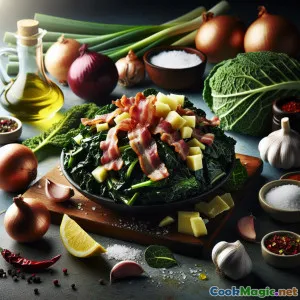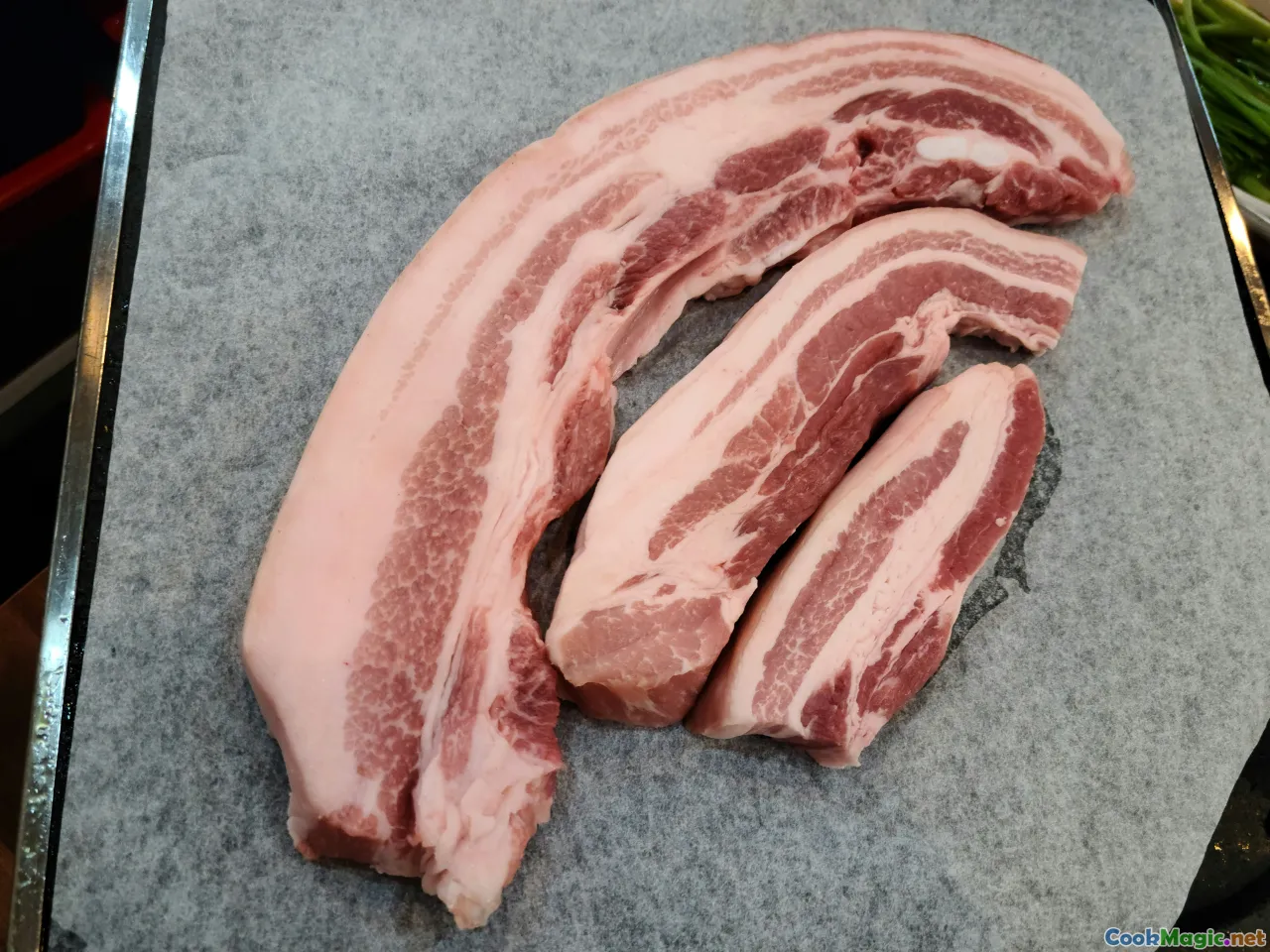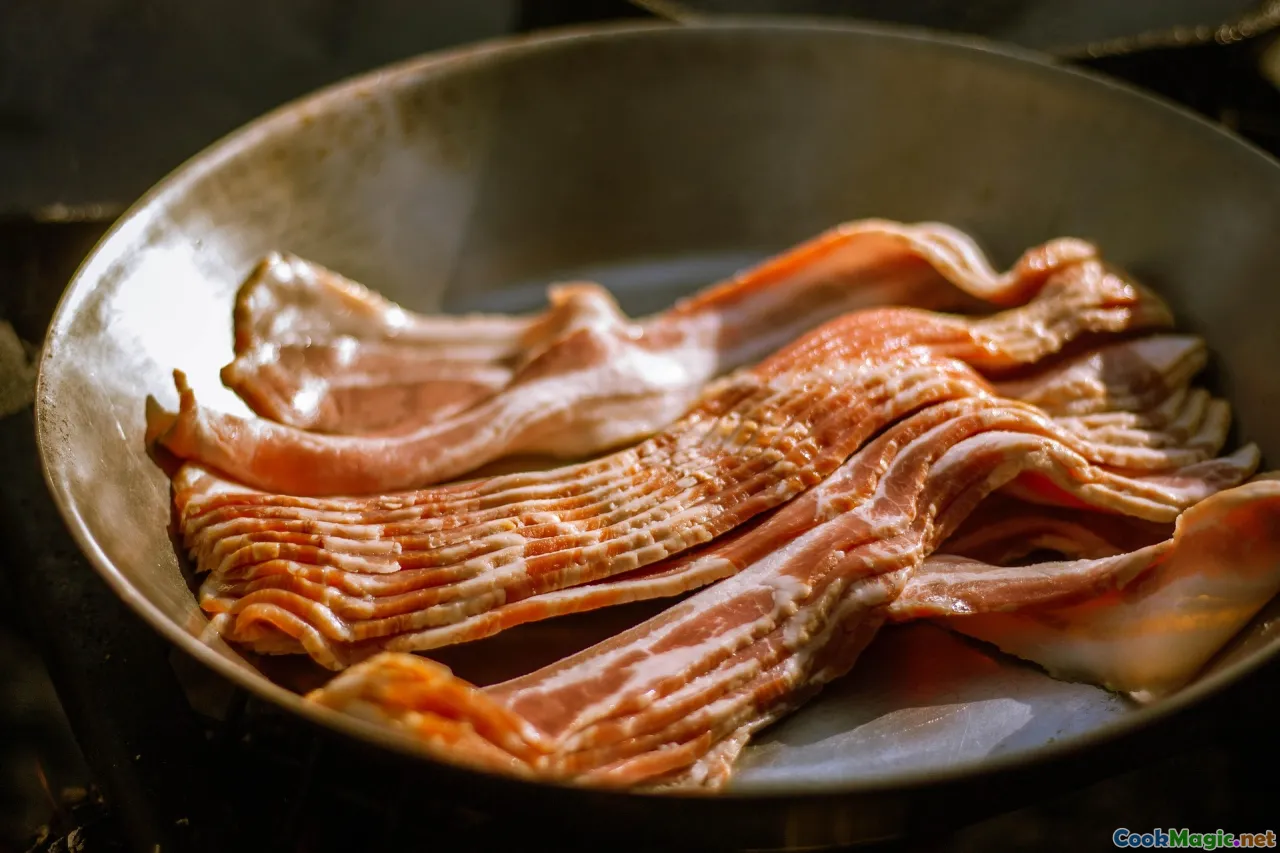
Południowy smażony jarmuż z chrupiącym boczkiem
(Southern Skillet Collard Greens with Crispy Bacon)
(0 Recenzje)0
1,122
lipiec 16, 2025
Zgłoś problem
Składniki
-
500 grams Jarmuż
(Świeże liście, usunięte grube łodygi i posiekane)
-
150 grams Bekon
(wędzony, pokrojony na małe kawałki)
-
1 medium Cebula żółta
(Drobno posiekane)
-
3 cloves Czosnek
(Mielony)
-
2 tbsp Ocet jabłkowy
(Nadaje zielonym liściom świeży połysk.)
-
400 ml rosół z kurczaka
(Można zastąpić bulionem warzywnym dla opcji wegetariańskiej.)
-
1 tbsp Oliwa z oliwek
(Wzmacnia smak, zwłaszcza do chrupiącego boczku.)
-
0.5 tsp Płatki czerwonej papryki
(Opcjonalnie, dla łagodnego kopnięcia ostrości.)
-
0.5 tsp Sól
(Do smaku; dopraw według uznania.)
-
0.5 tsp Czarny pieprz
(Świeżo rozkruszone lub zmielone)
(Świeże liście, usunięte grube łodygi i posiekane)
(wędzony, pokrojony na małe kawałki)
(Drobno posiekane)
(Mielony)
(Nadaje zielonym liściom świeży połysk.)
(Można zastąpić bulionem warzywnym dla opcji wegetariańskiej.)
(Wzmacnia smak, zwłaszcza do chrupiącego boczku.)
(Opcjonalnie, dla łagodnego kopnięcia ostrości.)
(Do smaku; dopraw według uznania.)
(Świeżo rozkruszone lub zmielone)
Wartości odżywcze
- Porcje: 4
- Wielkość porcji: 1 miska (200g)
- Calories: 195 kcal
- Carbohydrates: 10 g
- Protein: 11 g
- Fat: 12 g
- Fiber: 4 g
- Sugar: 2 g
- Sodium: 550 mg
- Cholesterol: 25 mg
- Calcium: 130 mg
- Iron: 1.8 mg
Instrukcje
-
1 - Przygotuj liście collard.:
Usuń grube łodygi z liści kolarda. Dokładnie opłucz, następnie ułóż w stos, zroluj i pokrój liście na cienkie wstążki.
-
2 - Usmaż bekon na chrupko:
Dodaj olej Oliwy na dużą patelnię na średnim ogniu. Smaż kawałki boczku, aż będą chrupiące, około 5–7 minut. Wyjmij je łyżką cedzakową i odłóż na bok, pozostawiając w patelni wytopiony tłuszcz.
-
3 - Smażyć cebulę i czosnek:
Dodaj pokrojoną w kostkę cebulę na patelnię z tłuszczem z boczku. Smaż, aż cebula zmięknie, około 3 minut, następnie dodaj czosnek i smaż jeszcze przez 1 minutę, aż zacznie pachnieć.
-
4 - Ugotuj liście kolard:
Dodaj liście collard do patelni. Wymieszaj, aby je równomiernie pokryć, i smaż przez 2–3 minuty. Wlej bulion drobiowy, doprowadź do lekkiego wrzenia, przykryj i gotuj 10–12 minut, od czasu do czasu mieszając, aż liście będą miękkie.
-
5 - Dopraw i dodaj boczek.:
Zdejmij pokrywkę. Wymieszaj ocet jabłkowy, płatki czerwonej papryki (jeśli używasz), sól i czarny pieprz. Włóż boczek z powrotem na patelnię i dobrze wymieszaj. Gotuj bez przykrycia na małym ogniu, aż większość płynu wyparuje.
-
6 - Serwować:
Spróbuj doprawić do smaku, a następnie przełóż liście kolarda z boczkiem do miseczek do podania. Podawaj na gorąco jako dodatek lub sycący lunch.
Usuń grube łodygi z liści kolarda. Dokładnie opłucz, następnie ułóż w stos, zroluj i pokrój liście na cienkie wstążki.
Dodaj olej Oliwy na dużą patelnię na średnim ogniu. Smaż kawałki boczku, aż będą chrupiące, około 5–7 minut. Wyjmij je łyżką cedzakową i odłóż na bok, pozostawiając w patelni wytopiony tłuszcz.
Dodaj pokrojoną w kostkę cebulę na patelnię z tłuszczem z boczku. Smaż, aż cebula zmięknie, około 3 minut, następnie dodaj czosnek i smaż jeszcze przez 1 minutę, aż zacznie pachnieć.
Dodaj liście collard do patelni. Wymieszaj, aby je równomiernie pokryć, i smaż przez 2–3 minuty. Wlej bulion drobiowy, doprowadź do lekkiego wrzenia, przykryj i gotuj 10–12 minut, od czasu do czasu mieszając, aż liście będą miękkie.
Zdejmij pokrywkę. Wymieszaj ocet jabłkowy, płatki czerwonej papryki (jeśli używasz), sól i czarny pieprz. Włóż boczek z powrotem na patelnię i dobrze wymieszaj. Gotuj bez przykrycia na małym ogniu, aż większość płynu wyparuje.
Spróbuj doprawić do smaku, a następnie przełóż liście kolarda z boczkiem do miseczek do podania. Podawaj na gorąco jako dodatek lub sycący lunch.
Więcej o: Południowy smażony jarmuż z chrupiącym boczkiem
Collard Greens with Bacon — Southern Tradition in Every Bite
Collard greens have a deeply rooted history in Southern American cuisine, stretching back over generations and oceans. Originating in Africa and Europe, leafy greens like collards became staple crops across the southern United States due to their resilient nature and hearty, nutritious leaves. Collard greens with bacon is an iconic dish—earthy greens slow-simmered until melt-in-your-mouth tender, enriched with smoky bacon, sweet onions, and spiked with a splash of vinegar to balance the richness.
History & Cultural Significance
For enslaved African Americans residing in the Antebellum South, collards were cultivated in gardens as essential sources of nutrition. Traditionally, they were slow-cooked with smoked meats (ham hocks, fatback, or bacon) to bring extra body and warmth, flavors that became emblematic of African American and Southern cuisine. Every Black family, and indeed, many white households in places like Georgia, the Carolinas, and Alabama developed their own approaches to seasoning, braising, and serving collard greens, often with personal or regional flourishes.
The custom of adding vinegar reflects West African cooking traditions, where acid is often used to brighten the intensity of long-cooked stews. Even today, a jar of peppered vinegar frequently sits on the table alongside greens.
Personal Tips & Notes
- Prepping the Greens: Always remove the thick center ribs—these don't tenderize well and can add unwanted bitterness. For speed, try stacking several leaves, rolling tightly, and slicing into 'chiffonade' style ribbons.
- Choosing Bacon: Use high-quality, smoky bacon for depth. Alternatively, try adding chopped smoked sausage or a ham hock for even more flavor, or opt for a plant-based bacon or smoked tofu for a vegetarian version.
- Simmering Liquid: Chicken stock gives a rounded base, but if making vegetarian, try mushroom or vegetable stock with a splash of smoked paprika.
- Final Touch: The table vinegar is traditional—pass a small bottle for diners wishing to add extra tang. Vinegar can cut through the greens' natural brassica bitterness and bacon's richness at the last second.
- Leftovers & Storage: These collard greens taste even better the next day. Refrigerate in an airtight container and enjoy within three days. Reheat gently over the stove with a splash of water or stock to restore moisture.
Creative Variations
For an intriguing, creative spin, add chopped sun-dried tomatoes or a pinch of brown sugar at the end for sweetness, or toss in a can of drained white beans to make a complete one-skillet meal. Chopped jalapeños roasted with bacon briefly or a sprinkle of toasted pecans over the top brings new depths and crunch. Steep collards in miso-infused broth for a unique global twist.
Beyond the Side — Serving Ideas
While classic Southern plates offer collards alongside cornbread, barbecue meats, or fried chicken, don’t hesitate to serve these as a main element for lunch over cheesy grits, as part of a rice bowl, or folded into a breakfast sandwich with egg. Their savory and comforting taste profile brings a warm balance at any time of day.
Quick Nutrition Glimpse
Collards bring potent doses of vitamins A, C, and K, calcium, and dietary fiber, supporting strong bones and digestion. Coupled with protein and healthy fats from bacon, this dish is a filling source of comfort-food nutrition.
The joyous blend of old-world culinary knowledge refined on this continent makes collard greens with bacon more than a recipe—it’s a celebration of history, resourcefulness, and flavor. Whether you grew up alongside a pot of simmering greens or you’re trying this Southern mainstay for the very first time, you’re partaking in a beloved legacy that links countless kitchens across centuries.

























